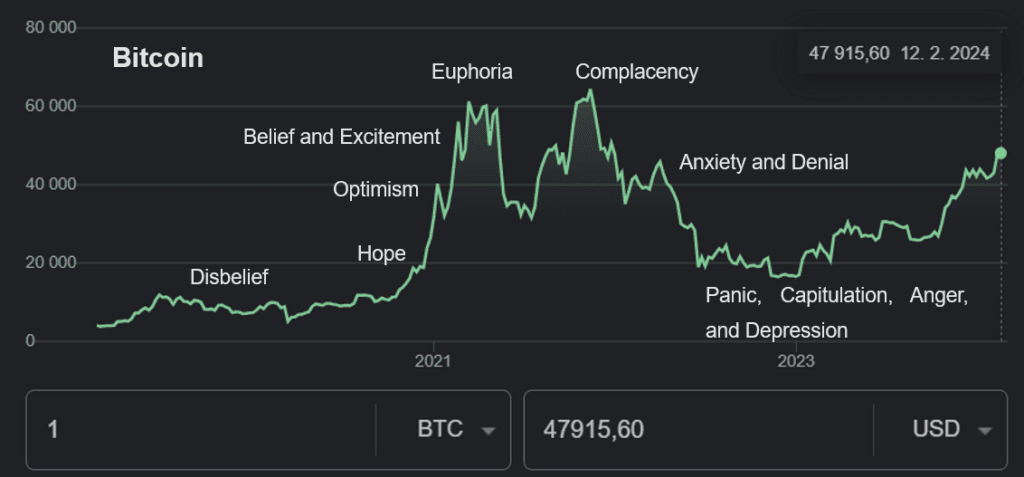
The difference between a profitable and a non-profitable trader often comes down to how they handle their emotions. While some investors may show the right emotions at the wrong time, leading to bad decisions, successful traders understand their emotions and use them to their advantage. To be successful in the market, you need to understand the psychology of the market, and that’s why this Wall Street cheat sheet is a valuable tool.
Table of content – Wall Street Cheat Sheet
The Psychology of Market Cycles
The chart outlines the emotional rollercoaster of the market cycle, but beneath the surface lies a complex interplay of psychological forces influencing investor behavior. Let’s dive deeper into each phase, exploring the intricate dance between emotions and decisions:

Disbelief
Following a bear market, a new upward trend ignites suspicion. Many, scarred by past losses, remain on the sidelines, questioning the rally’s legitimacy. “Is this just a dead cat bounce?” they wonder. Even experienced investors might hesitate, battling internal narratives of cautiousness while witnessing early gains. This phase highlights the power of anchoring bias, where past experiences color current perceptions, potentially leading to missed opportunities.
Don’t miss out: TOP 10 ways to make money online – and what to look out for?
Hope
As the uptrend persists, a glimmer of optimism emerges. Those who initially disbelieved might start considering entering, fueled by the fear of missing out (FOMO). Others, emboldened by the rising prices, cautiously dip their toes in, their hope blossoming with each upward tick. This phase demonstrates the influence of social proof, where investor behavior is swayed by the actions of others, creating a snowball effect of buying.
Optimism
The market ignites, fueled by a rising tide of optimism. News outlets trumpet the rally, further amplifying the positive sentiment. Investors, now fully convinced of the uptrend, pour in, their confidence bolstered by a sense of invincibility. This phase showcases the irrational exuberance phenomenon, where emotions cloud judgment, leading to overvalued assets and risky investments.
Belief and Excitement
The market reaches fever pitch. Everyone seems to be talking about the “next big thing,” their voices charged with excitement. Euphoria sets in, fueled by the belief that prices will continue to skyrocket indefinitely. Confirmation bias takes hold, where investors seek out information that confirms their bullish outlook, ignoring any signs of potential trouble. This phase exemplifies the dangers of the greater fool theory, where investors buy based on the belief that someone else will always pay more.
Euphoria
In this phase, prices reach extreme levels, and people throw caution to the wind. Investors use new metrics and valuation methods to justify the rally. This is where the “greater fool” theory comes into play: the idea that no matter how high prices go, there will always be someone willing to buy them.
Might interest you: Zetano – Regulatated broker review
Complacency
In this phase, the market momentum stalls, and there might be a pullback. However, this pullback is often followed by a small rally, making it seem like the uptrend is continuing. Traders hold onto their positions, thinking it’s just a temporary setback. They fail to realize that the market has reached its peak and is ready to reverse course.
Anxiety and Denial
As cracks appear in the facade, anxiety creeps in. Savvy investors start taking profits, sensing the impending reversal. However, many remain in denial, clinging to the hope that the rally will resume. This phase demonstrates the loss aversion bias, where the pain of losses looms larger than the pleasure of gains, leading investors to hold onto losing positions longer than they should.

Panic, Capitulation, Anger, and Depression
The bubble bursts, and the market plummets. Panic sets in, triggering a wave of selling. Investors, facing margin calls and significant losses, capitulate, their dreams shattered. Anger and depression engulf them as they come to terms with the harsh reality. This phase exposes the recency bias, where we focus on recent events, causing us to overestimate the likelihood of another crash.
Understanding these intricate emotional dynamics is crucial for navigating the market cycles. By recognizing and mitigating the impact of cognitive biases, investors can make more informed decisions and ultimately achieve their financial goals. However, the journey requires constant learning, self-awareness, and emotional intelligence – a lifelong pursuit in the ever-evolving dance of the market.
Trading Strategies
To be successful on Wall Street, you need to have effective trading strategies that consider the emotional swings of the market cycle. The Wall Street cheat sheet you see here can help you understand market psychology and the emotions that investors experience throughout different stages of the cycle. It emphasizes the importance of emotional control for profitable trading and shows how understanding market psychology can lead to success.
By outlining the emotions associated with each stage of the cycle, from disbelief and hope to euphoria and depression, the cheat sheet helps traders develop a comprehensive understanding of the market’s emotional landscape. This awareness allows traders to anticipate and navigate market movements more effectively, using a strategic approach that avoids emotional pitfalls. In short, the cheat sheet is a valuable tool for traders who want to improve their financial results by incorporating an understanding of market psychology into their trading strategies.
Read also: Accurate Fx Review
Conclusion
The market’s emotional rollercoaster can be daunting, but understanding its dynamics empowers you to navigate its twists and turns. This Wall Street cheat sheet serves as a compass, guiding you through the emotional states at each stage: disbelief’s cautious whispers, hope’s hesitant steps, optimism’s bold stride, and the intoxicating dance of euphoria. Be wary of complacency’s siren song, recognize the warning signs of anxiety, and navigate the turbulence of panic with a cool head. Remember, even despair gives way to new beginnings. By mastering your emotions and leveraging this knowledge, you gain a distinct edge in the ever-evolving market dance.











